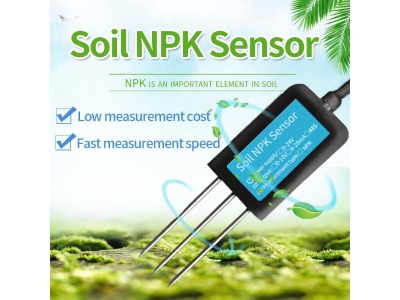Climate change is one of the most pressing issues of our time, and its impact on agriculture is significant. As the global population continues to grow, the need for sustainable and efficient agricultural practices becomes increasingly important. Climate-smart agriculture, which aims to increase productivity, resilience, and reduce greenhouse gas emissions, has become a key strategy in addressing the challenges posed by climate change. Deploying soil sensors is one of the key technologies that can help farmers achieve climate-smart agriculture, but it also presents opportunities and challenges.

Soil sensors are devices that are used to measure various soil properties
such as moisture content, temperature, and nutrient levels. These sensors can provide real-time data on soil conditions, allowing farmers to make informed decisions about irrigation, fertilization, and other farming practices. By using soil sensors, farmers can optimize their resource use, reduce input costs, and minimize environmental impact. This technology has the potential to revolutionize agriculture and make it more sustainable in the face of climate change.
One of the key opportunities presented by deploying soil sensors is the potential for increased productivity
By monitoring soil conditions in real-time, farmers can ensure that their crops receive the right amount of water and nutrients, leading to higher yields. This not only benefits farmers by increasing their income, but it also contributes to global food security by ensuring a stable and reliable food supply. Additionally, by using soil sensors to optimize resource use, farmers can reduce their environmental footprint and contribute to the mitigation of climate change.
Another opportunity presented by soil sensors is the potential for increased resilience in the face of climate change. With changing weather patterns and more frequent extreme weather events, farmers need to be able to adapt to these challenges. Soil sensors can help farmers to better understand their soil conditions and make adjustments to their farming practices in response to changing weather patterns. By using soil sensors, farmers can improve their ability to cope with the impacts of climate change and ensure the long-term sustainability of their operations.
However, deploying soil sensors for climate-smart agriculture also presents a number of challenges
One of the main challenges is the cost of the technology. Soil sensors can be expensive to purchase and install, and many small-scale farmers may not have the financial resources to invest in this technology. Additionally, there may be ongoing costs associated with maintaining and calibrating the sensors, which could further limit the adoption of this technology, particularly in developing countries.
Another challenge is the need for technical expertise in using soil sensors
Farmers need to be able to interpret the data provided by the sensors and make informed decisions based on this information. This may require training and support to ensure that farmers are able to effectively use soil sensors to improve their farming practices. Additionally, there may be a need for technical support and troubleshooting to address any issues that arise with the sensors, which could be a barrier for some farmers.
Furthermore
there may be challenges related to data management and integration. Soil sensors generate large amounts of data, and farmers need to be able to effectively manage and analyze this information to derive meaningful insights. Additionally, there may be challenges in integrating the data from soil sensors with other farm management systems, such as irrigation and fertilization systems. This requires a high level of technical expertise and may be a barrier for some farmers.

Despite these challenges, the potential benefits of deploying soil sensors for climate-smart agriculture are significant. By providing real-time data on soil conditions, soil sensors can help farmers to optimize their resource use, increase productivity, and improve resilience in the face of climate change. However, in order to fully realize these benefits, it is important to address the challenges associated with deploying soil sensors. This may require financial support to make the technology more accessible to small-scale farmers, as well as training and technical support to ensure that farmers are able to effectively use soil sensors to improve their farming practices. Additionally, there may be a need for research and development to further improve the technology and address any remaining challenges.
In conclusion, deploying soil sensors for climate-smart agriculture presents both opportunities and challenges. While this technology has the potential to revolutionize agriculture and make it more sustainable in the face of climate change, there are a number of barriers that need to be addressed in order to fully realize these benefits. By addressing the challenges associated with deploying soil sensors, we can help farmers to improve their productivity, resilience, and environmental sustainability, contributing to a more secure and sustainable food supply in the face of climate change.
